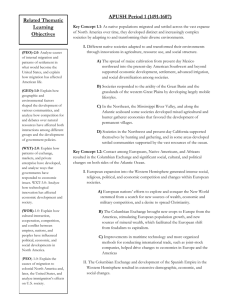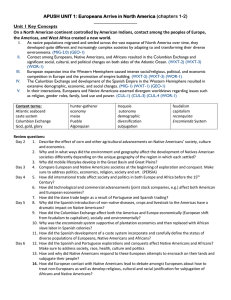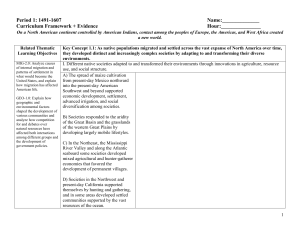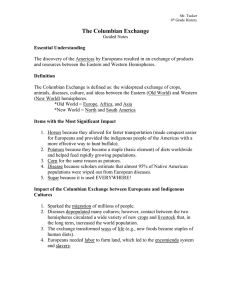Early American History: Native Societies & Columbian Exchange
advertisement
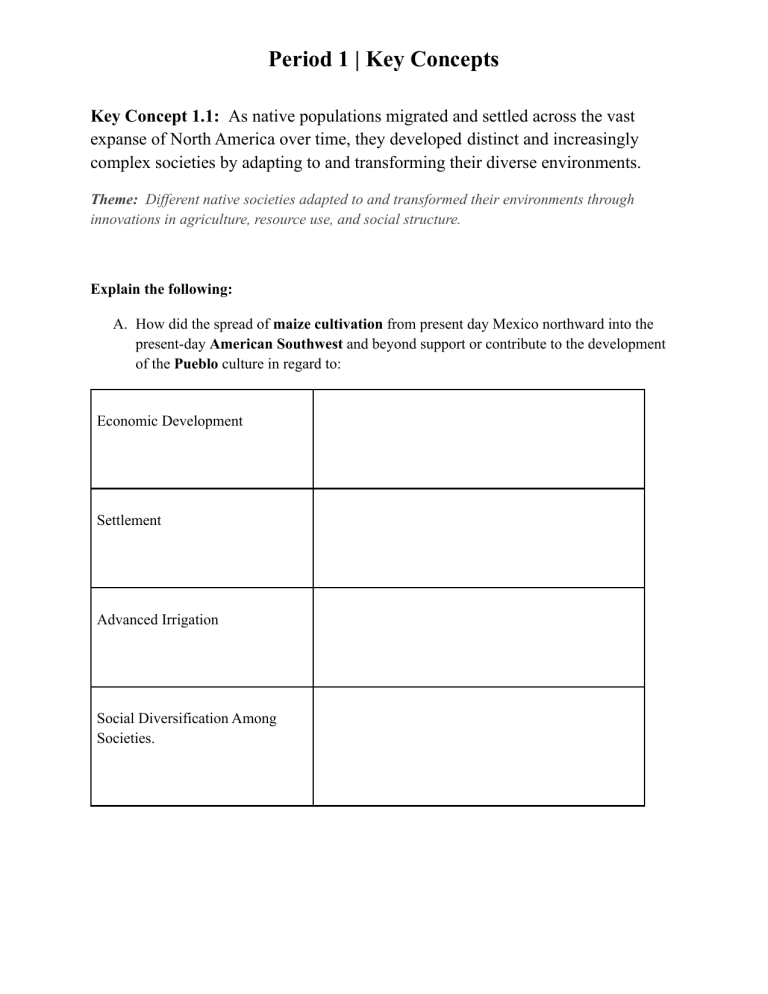
Period 1 | Key Concepts Key Concept 1.1: As native populations migrated and settled across the vast expanse of North America over time, they developed distinct and increasingly complex societies by adapting to and transforming their diverse environments. Theme: Different native societies adapted to and transformed their environments through innovations in agriculture, resource use, and social structure. Explain the following: A. How did the spread of maize cultivation from present day Mexico northward into the present-day American Southwest and beyond support or contribute to the development of the Pueblo culture in regard to: Economic Development Settlement Advanced Irrigation Social Diversification Among Societies. Period 1 | Key Concepts B. Explain the following statement: “Societies responded to the aridity of the Great Basin and the grasslands of the western Great Plains by developing largely mobile lifestyles.” C. Identify and explain at least one Native American group that developed mixed agricultural and hunter gatherer economies that favored the development of permanent villages in the following regions: The Northeast (Atlantic Seaboard) The Mississippi River/Ohio River Valleys The Southeast (Atlantic Seaboard) D. Identify and explain at least one Native American society in either the Northwest or present-day California that supported themselves by hunting and gathering, and perhaps developed settled communities supported by the vast resources of the ocean. Period 1 | Key Concepts Key Concept 1.2: Contact among Europeans, Native Americans, and Africans resulted in the Columbian Exchange and significant social, cultural, and political changes on both sides of the Atlantic Ocean. THEME: European expansion into the Western Hemisphere generated intense social, religious, political, and economic competition and changes within European societies. A. Identify and explain at least one example that supports the following regarding European nations’ motivations and efforts to explore and conquer the New World: Search for new sources of Wealth Economic and Military Competition Desire to spread Christianity Period 1 | Key Concepts B. “The Columbian Exchange brought new crops to Europe from the Americas, stimulating European population growth, and new sources of mineral wealth, which facilitated the European shift from feudalism to capitalism.” Explain the above statement: C. Explain Improvements in maritime technology during this period. D. Identify and explain how joint-stock companies helped drive changes to economies in Europe and the Americas . Theme: The Columbian Exchange and development of the Spanish Empire in the Western Hemisphere resulted in extensive demographic, economic, and social changes. Subtheme: Spanish exploration and conquest of the Americas were accompanied and furthered by widespread deadly epidemics that devastated native populations and by the introduction of crops and animals not found in the Americas. A. The Columbian Exchange: Identify and explain at least two examples to support each of the following and explain its impact on the Americas: 2 examples brought to the Americas Impact to the Americas 2 examples brought to Europe Period 1 | Key Concepts Plants Animals Diseases (only one example) B. ID the Encomienda System using the SCAR (Subject, Causes—long-term and short-term, Actions, Results— long-term and short-term) method C. ID the African Slave Trade using the SCAR (Subject, Causes—long-term and short-term, Actions, Results— long-term and short-term) method Period 1 | Key Concepts D. The Spanish developed a caste system that incorporated, and carefully defined the status of, the diverse population of Europeans, Africans, and Native Americans in their empire. Explain the following: ● Peninsulares ● Creoles ● Mestizos/Mullatoes THEME: In their interactions, Europeans and Native Americans asserted divergent worldviews regarding issues such as religion, gender roles, family, land use, and power. A. Explain misunderstandings (differences) between the Native-Americans and the Europeans regarding: ● Trade ● Gender Roles ● Religion Period 1 | Key Concepts B. Identify and explain ways in which the Europeans and Native-Americans adopted aspects of each other’s culture. C. As European encroachments on Native Americans’ lands and demands on their labor increased, native peoples sought to defend and maintain their political sovereignty, economic prosperity, religious beliefs, and concepts of gender relations through diplomatic negotiations and military resistance. Explain the above statement and give ONE example of military resistance against the Europeans (using the SCAR method) D. Extended contact with Native-Americans and Africans fostered a debate among European religious and political leaders about how non-Europeans should be treated, as well as evolving religious, cultural, and racial justifications for the subjugation of Africans and Native Americans. Support this statement with ONE piece of evidence
